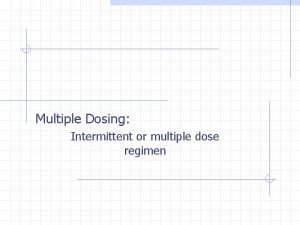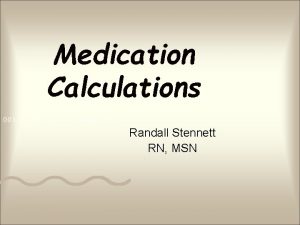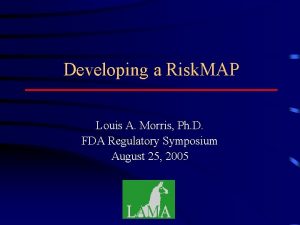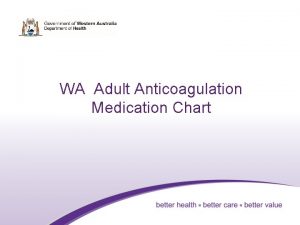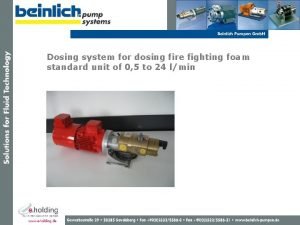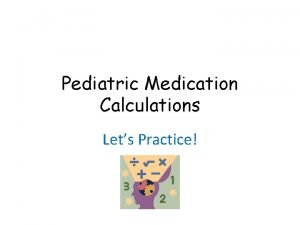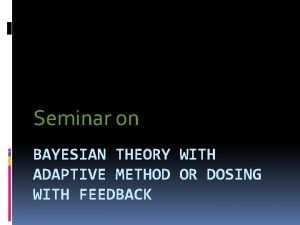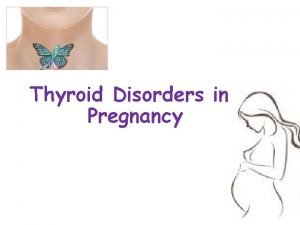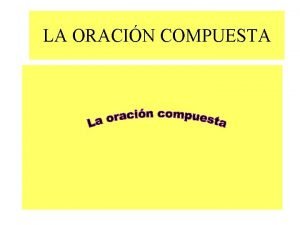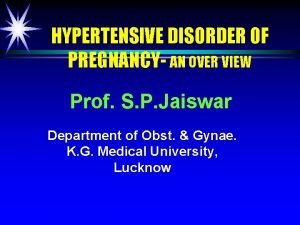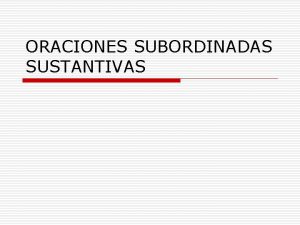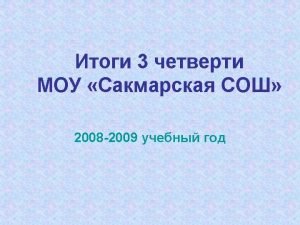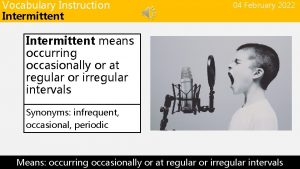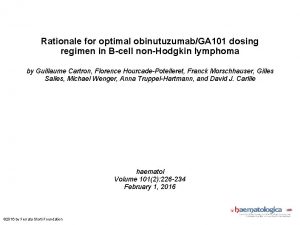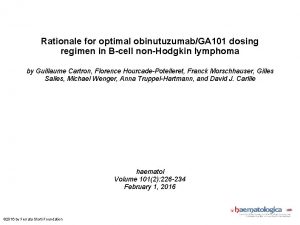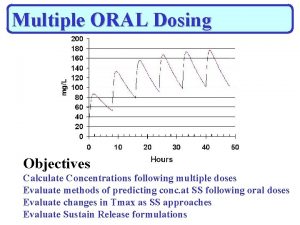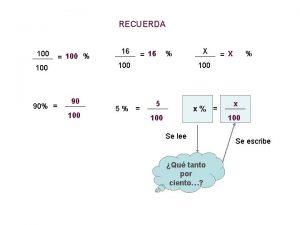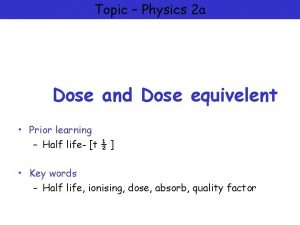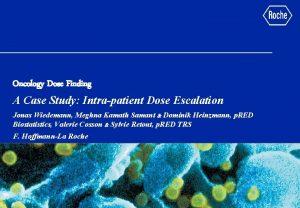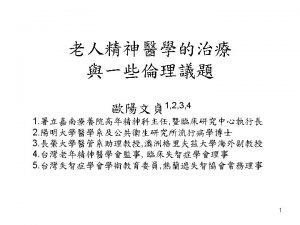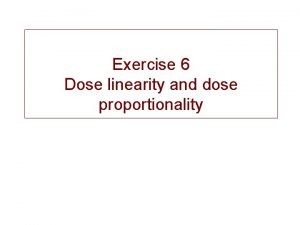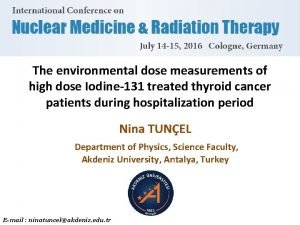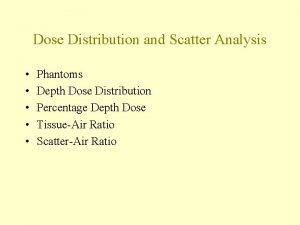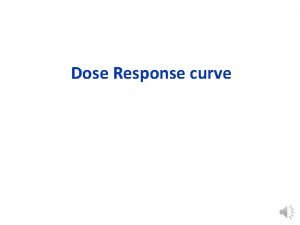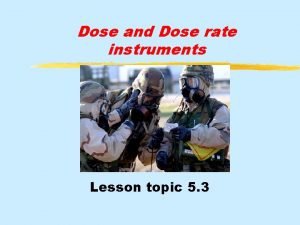Multiple Dosing Intermittent or multiple dose regimen 100

![100 mg q. t 1/2 via i. v. bolus Amount in Body [mg] 200 100 mg q. t 1/2 via i. v. bolus Amount in Body [mg] 200](https://slidetodoc.com/presentation_image/dd510e0cdddcf512f5a022805a533c57/image-2.jpg)
























![Check Css, max = [(0. 8)(200)/35]/(1 – e-(0. 143)(6)) = 7. 93 mg/l Css, Check Css, max = [(0. 8)(200)/35]/(1 – e-(0. 143)(6)) = 7. 93 mg/l Css,](https://slidetodoc.com/presentation_image/dd510e0cdddcf512f5a022805a533c57/image-27.jpg)


- Slides: 29

Multiple Dosing: Intermittent or multiple dose regimen
![100 mg q t 12 via i v bolus Amount in Body mg 200 100 mg q. t 1/2 via i. v. bolus Amount in Body [mg] 200](https://slidetodoc.com/presentation_image/dd510e0cdddcf512f5a022805a533c57/image-2.jpg)
100 mg q. t 1/2 via i. v. bolus Amount in Body [mg] 200 150 100 50 Time [t 1/2]: 1 2 3 4 5 6

Principle: 1 dose lost per At steady state, Rate In = Rate Out F • Dose = Ass, max - Ass, min = Ass, maxe-KE F • Dose = Ass, max (1 - e-KE ) Ass, max = F • Dose / (1 - e-KE ) Ass, min = Ass, max - F • Dose

AN, max & AN, min N= 1 2 Not AN, min = AN, max - F • Dose 3 4 Why? 5 6 7

Css, max & Css, min

Average amount of drug in the body at steady state At steady state, Rate In = Rate Out F Dose/ = KE Ass, av 1/KE = t 1/2/ln 2 = 1. 44 t 1/2

Average steady-state plasma concentration

AUC Equal Areas

Css, av Concept applies to all routes of administration and it is independent of absorption rate.

Dosing rate from AUC 0 - Given AUC after a single dose, D, the maintenance dose, DM , is: Where D produced the AUC 0 - , Css, av is the desired steady-state plasma concentration, and desired dosing interval. is the

Example: 50 mg p. o. dose 2 3 2. 4 1. 8 Cp mg/L 1 2 4 8 Time [h] AUC = 1+2. 5+5. 4+8. 4+6 = 23. 3 mg • h/L

Example, continued Calculate a dosing regimen for this drug that would provide an average steady-state plasma concentration of 15 mg/L. DM = 193 mg Dosing regimen: 200 mg q. 6 h.

Example, continued - 2 There is a problem with this approach ? ? Peak and trough concentrations are unknown. Css, max Css, min

Another example - digitoxin t 1/2 = 6 days; usual DR is 0. 1 mg/day Assuming rapid and complete absorption of digitoxin, What would be the average steady-state body level? Maximum and minimum plateau values? Is there accumulation of digitoxin? How long to reach steady state? Ass, av = 1. 44 F Dose t 1/2/ = (1. 44)(1)(0. 1 mg/d)(6 d)/(1 d) = 0. 864 mg Ass, max = 0. 1/(1 -e-(0. 116)(1)) = 0. 909 mg Ass, min = 0. 909 – 0. 1 = 0. 809 mg

Rate of Accumulation, AI, FI The rate of accumulation depends on the half-life of the drug: 3. 3 x t 1/2 gives 90% of the steady-state level. Accumulation Index (AI): Ass, max/F DM = (1 – e-KE )-1 Fluctuation Index (FI): Ass, max/Ass, min = e+KE KE AI KE FI When = t 1/2 AI = FI = 2

Absorption Rate influence on Rate of Accumulation v ka CL KE = 0. 1

When ka >> KE, control is by drug t 1/2: When ka << KE, control is by absorption t 1/2:

Loading Dose (LD) = Ass, max F Whether a LD is needed depends upon: • Accumulation Index • Therapeutic Index • Drug t 1/2 • Patient Need

Dosing Regimen Design OBJECTIVE: Maintain Cp within therapeutic window. Cp Time

Dosing Regimen Design APPROACH: Calculate max and DM, max. Cu Cp max Time Cl

DM, max and Dosing Rate From the principle that one dose is lost over a dosing interval at steady state: DM, max = (V/F)(Cu - Cl) Cp The Dosing Rate (DR) is DM, max Time

KEV = CL (Cu - Cl)/ln(Cu/Cl) = Css, av = logarithmic average of Cu and Cl. The log average is the concentration at the midpoint of the dosing interval; it’s less than the arithmetic average. Cu DR = (CL/F)Css, av max Cl

Average Concentration Approach 1. Choose the average to maintain: Css, av = (Cu - Cl)/ln (Cu/Cl) 2. Choose : max ; usually 4, 6, 8, 12, 24 h 3. Calculate DR: DR = (CL/F)Css, av 4. Calculate DM: DM = DR •

Example V = 35 L KE = 0. 143 h-1 t 1/2 = 4. 85 h CL = 5 L/h F = 0. 80 Cu = 10 mg/L Cl = 3 mg/L Css, av = (10 – 3)/ln (10/3) = 5. 8 mg/L max = (1. 44)(4. 85)[ln (10/3)] = 8. 41 h Choose < max: 8 h DR = (5 L/h)(5. 8 mg/L)/(0. 8) = 36. 25 mg/h DM = (36. 25 mg/h)(8 h) = 290 mg 300 mg Dosing Regimen: 300 mg q 8 h

Peak Concentration Approach 1. Choose the peak concentration to maintain. 2. Choose : max ; usually 4, 6, 8, 12, 24 h 3. Calculate DM: DM = (V • Cpeak/F)(1 - e-KE ) from:

Example V = 35 L KE = 0. 143 h-1 t 1/2 = 4. 85 h CL = 5 L/h F = 0. 80 Cu = 10 mg/L Cl = 3 mg/L Cpeak = 8 mg/L max = (1. 44)(4. 85)[ln (10/3)] = 8. 41 h Choose < max: 6 h set to 6 h so that Css, min > Cl DM = [(35 L)(8 mg/L)/0. 8](1 – e-(0. 143)(6)) = 202 mg Dosing Regimen: 200 mg q 6 h
![Check Css max 0 8200351 e0 1436 7 93 mgl Css Check Css, max = [(0. 8)(200)/35]/(1 – e-(0. 143)(6)) = 7. 93 mg/l Css,](https://slidetodoc.com/presentation_image/dd510e0cdddcf512f5a022805a533c57/image-27.jpg)
Check Css, max = [(0. 8)(200)/35]/(1 – e-(0. 143)(6)) = 7. 93 mg/l Css, min = 7. 93 - (0. 8)(200)/35 = 3. 4 mg/L

Rationale for controlled release dosage forms Compliance vs. fluctuation: when the dosing interval is less than 8 h, compliance drops. n n n For short half-life drugs, either must be small (2, 3, 4, 6 h), or the fluctuation must be quite large, when conventional dosage forms are used. Use of controlled release permits long while maintaining low fluctuation. Not generally of value for drugs with long half lives (> 12 h). Due to extra expense, they should not be recommended.

Assessment of PK parameters CL: CL/F = (DM/ )/Css, av and Css, av = AUCss, / Relative F: CLR: CLR = (Ae , ss/Css, av) where Ae , ss is the amount of drug excreted in the urine over one .
 100 100 100 100 100
100 100 100 100 100 Intermittent dosing
Intermittent dosing Eliquis dosing for afib
Eliquis dosing for afib Ivpb medication
Ivpb medication Trazadane
Trazadane Pirfenidone dose
Pirfenidone dose Tikosyn dosing guide
Tikosyn dosing guide Warfarin
Warfarin Foam dosing system
Foam dosing system Lovenox renal dosing
Lovenox renal dosing How to chew nicotine gum
How to chew nicotine gum Cummins def dosing unit location
Cummins def dosing unit location 40 french bougie
40 french bougie Amoxicillin dosage chart by weight
Amoxicillin dosage chart by weight Document editor
Document editor Adaptive method or dosing with feedback
Adaptive method or dosing with feedback Treatment for hyperthyroidism in pregnancy
Treatment for hyperthyroidism in pregnancy Insulin dosing guidelines
Insulin dosing guidelines Coordinación y yuxtaposición
Coordinación y yuxtaposición Pritchard regimen
Pritchard regimen Regimen sancionatorio ambiental
Regimen sancionatorio ambiental Origen del modelo tradicional
Origen del modelo tradicional Regimen pro pyme general (14d) 3
Regimen pro pyme general (14d) 3 Que es regimen general
Que es regimen general Cual es el complemento indirecto
Cual es el complemento indirecto Régimen sancionatorio del sgrl
Régimen sancionatorio del sgrl Comercio en el antiguo regimen
Comercio en el antiguo regimen Antiguo regimen definicion
Antiguo regimen definicion Régimen disciplinario losep
Régimen disciplinario losep Que es la reforma pro salud
Que es la reforma pro salud

